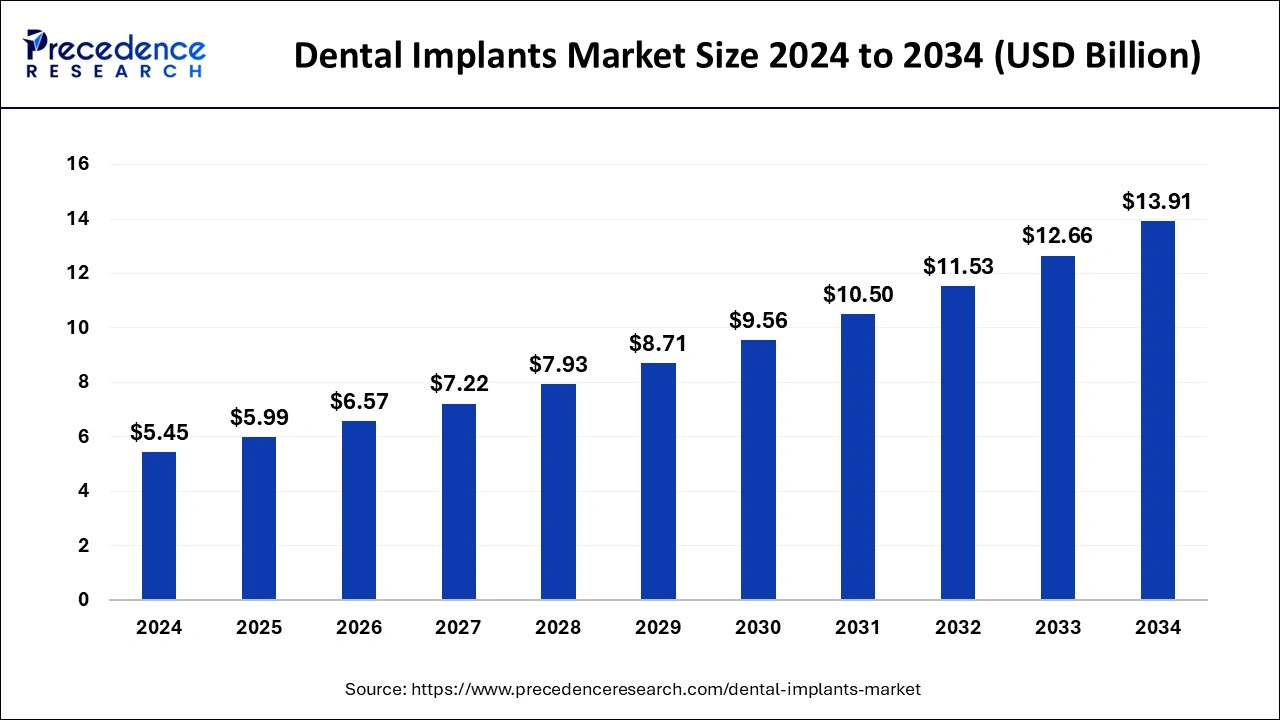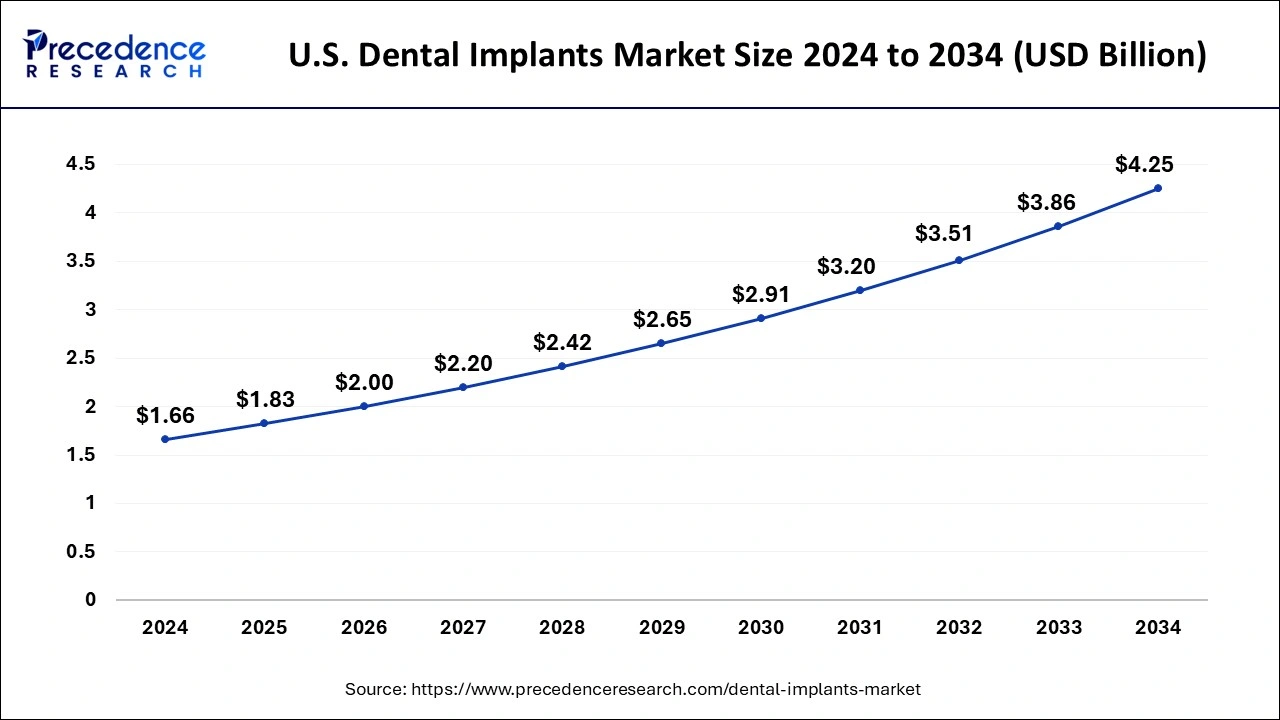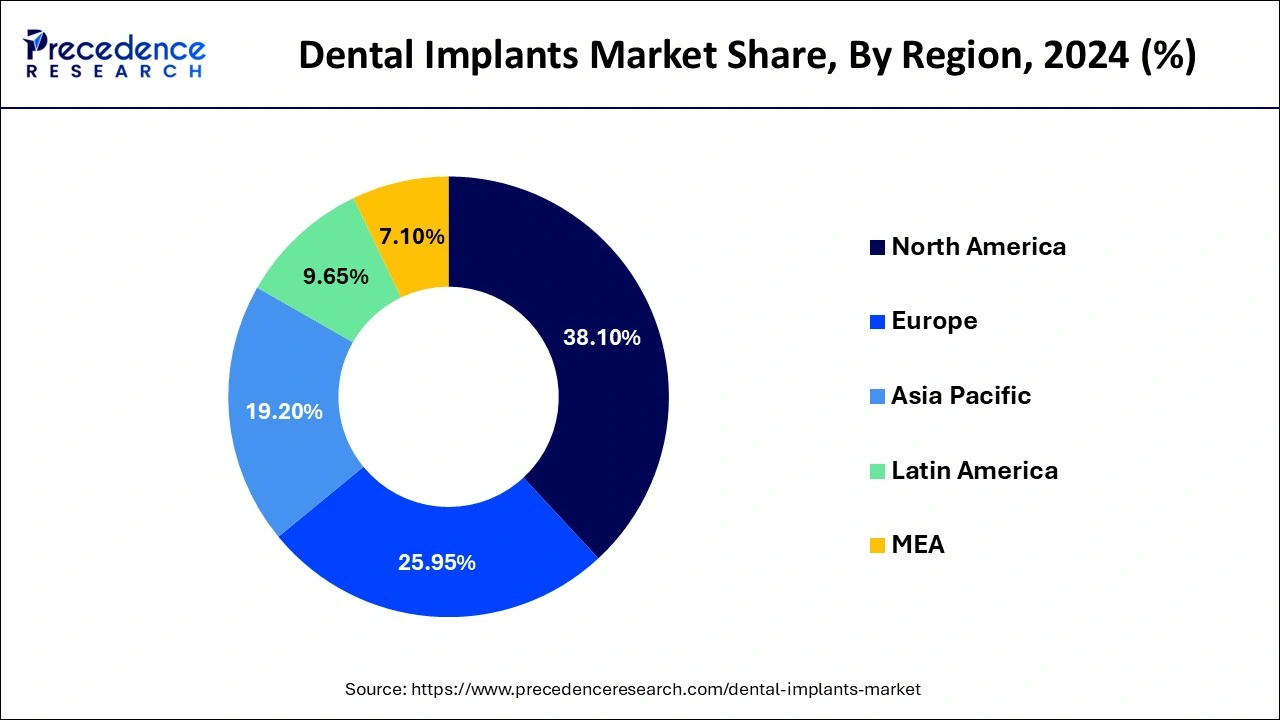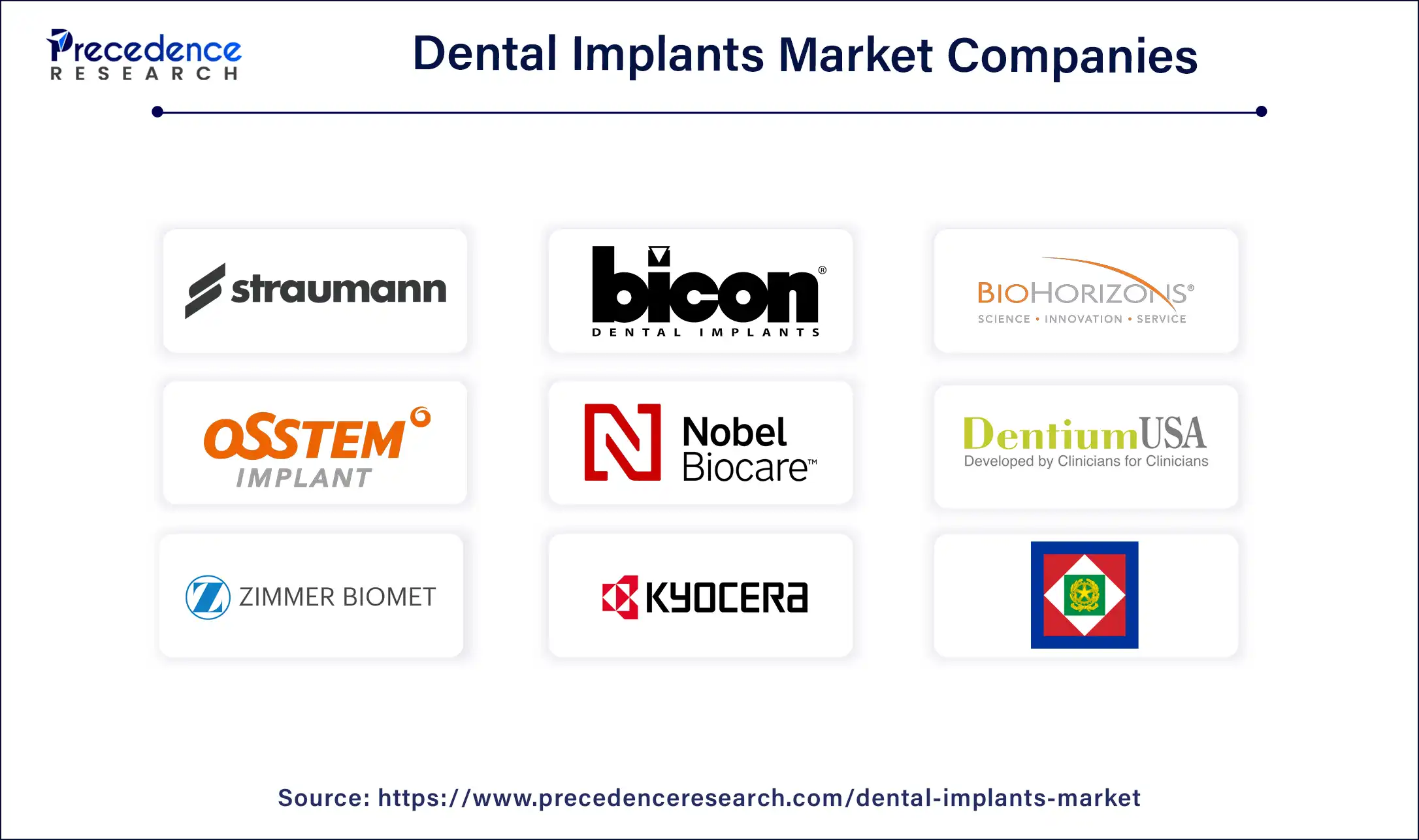List of Contents
Dental Implants Market Size and Forecast 2025 to 2034
The global dental implants market size was estimated at USD 5.45 billion in 2024 and is anticipated to reach around USD 13.91 billion by 2034, expanding at a CAGR of 9.82% from 2025 to 2034.

Dental Implants Market Key Takeaways
- In terms of revenue, the market is valued at $5.99 billion in 2025.
- It is projected to reach $13.91 billion by 2034.
- The market is expected to grow at a CAGR of 9.82% from 2025 to 2034.
- North America dominated the dental implants market the largest market share of 38.10% in 2024.
- Asia Pacific is expected to grow fastest during the forecast period.
- By material insights, the titanium segment contributed the highest market share of 92% in 2024.
- By material insights, the zirconium segment is expected to grow fastest during the forecast period.
- By product insights, the tapered segment dominated the dental implants market in 2024.
- By product insights, the parallel wall implants segment is expected to grow fastest during the forecast period.
- By end-user insights, the dental clinic segment dominated the market share in 2024.
- By end-user insights, the hospitals segment expected to grow fastest during the forecast period.
How is AI changing the dental procedures?
The dentistry industry has experienced a paradigm preference with the advent of dental implants. These innovative biocompatible fixtures provide an aesthetically and permanent pleasing solution for missing teeth, fostering enhanced oral health and overall well-being. There are various advantages of this AI integration in dental implants, such as optimizing efficiency and cost, improved patient comfort, reduced risk and faster recovery, personalized treatment and enhanced planning and precision.
AI has the ability to analyze huge amounts of patient data, such as digital impression and 3D scans. AI algorithms can help dentists tailor treatment plans to each individual's needs, by analyzing patient data and medical history, AI can contribute to a reduction in surgical risks like nerve damage or infection, with more accurate planning and implant placement. AI can contribute to overall efficiency in implant procedures, by streamlining workflows and potentially reducing complications, further contributed to revolutionize the growth of the dental implants market. In addition, with even more exciting possibilities on the horizon, the integration of AI in implant dentistry is still evolving.
U.S. Dental Implants Market Size and Growth 2025 to 2034
The U.S. dental implants market size was evaluated at USD 1.66 billion in 2024 and is predicted to be worth around USD 4.25 billion by 2034, rising at a CAGR of 9.86% from 2025 to 2034.

North America dominated the global dental implants market, garnering a market share of around 38.10% in 2024. The presence of high geriatric population in the region and rising incidences of tooth decay and dental carries is driving the market growth. According to the CDC, about 16% of the population aged between 5 years to 19 years and about 31% of the population aged between 20 years to 44 years in US lives with dental carries. The increasing number of campaigns and initiatives by the organizations like American Dental Association has significant contributions in spreading the awareness among the population regarding dental carries. The rising adoption of advanced dental equipment, increased prevalence of edentulism, and higher acceptance of digital dentistry are among the major factors that has driven the growth of the North America dental implants market.

Asia Pacific is estimated to be the most opportunistic market during the forecast period. The surging number of geriatric population, rising number of road accidents, rising healthcare expenditure, rising personal disposable income, rising awareness regarding the cosmetic dentistry, growing prevalence of dental carries among the children and adult population, and rising penetration of dental clinics in the region are some of the significant factors that are expected to drive the growth of the dental implants market in Asia Pacific. According to the United Nations, around 80% of the global geriatric population will be living in low and middle income countries by 2050. Moreover, as per the World Health Organization, around 93% of the road accidents occur in the low and middle income countries. The rising adoption of the digital technologies in the hospitals and dental clinics will significantly contribute towards the market growth.
Market Overview
Dental implants market deals with artificial tooth roots, typically made from titanium, that are surgically placed into the jawbone to replace missing teeth. These metal frames or posts are designed to offer a strong foundation for removable replacement or fixed teeth that are made to match natural teeth. The market growth is attributed to the rising demand for cosmetic dentistry, rising number of dental problems and increasing rate if tooth decay.
In addition, focus on oral healthcare, higher life expectancy and better quality of life are the major factors expected to drive the growth of the dental implants market. Furthermore, increasing adoption of inorganic growth strategies such as partnership and acquisition by major market players are anticipated to enhance the market growth.
Global Export of Dental Implant
- From October 2023 to September 2024, the world exported 53,401 shipments of Dental Implants. A total of 966 Exporters sold to 1,083 Buyers, reflecting an 8% increase compared to the previous year. During this timeframe, in September 2024 specifically, there were 4,657 dental implant export shipments conducted globally. This signifies a 4% increase on a year-over-year basis in comparison to September 2023. Worldwide, the leading three exporters of Dental Implants are South Korea, Israel, and Switzerland. South Korea tops the global market in Dental Implant exports with 64,123 shipments, while Israel follows with 44,095 shipments, and Switzerland ranks third with 34,845 shipments.
Dental Implants Market Growth Factors
- The surging incidences of oral and tooth loss problems among the population owing to the various factors such as poor eating habits, aging, lack of oral hygiene, and accidents is a significant factor that boosts the demand for the dental implants across the globe.
- The rising awareness regarding the availability of advanced dental implants and their benefits and the rising prevalence of tooth loss is spurring the demand for dental implants among the people.
- The desire to look good and presentable at all times among the young population is encouraging them to adopt dental implants for improving their facial aesthetics. The various advantages of dental implants are safety, natural looking teeth, durability, and effectiveness which drives the demand for dental implants market across the globe.
- The growing applications of computer aided design and computer aided manufacturing technologies has resulted in the cost-effective production of dental implants. This technology enables non-invasive surgeries and lower healing time which further fuels market growth.
- The surging demand for the CAD/CAM technologies, dental scanners, 3D printing technology, and CBCT across the dental industry is expected to have a positive and exponential impact on the global dental implants market during the forthcoming years.
Market Scope
| Report Coverage | Details |
| Market Size in 2024 | USD 5.45 Billion |
| Market Size in 2025 | USD 5.99 Billion |
| Market Size by 2034 | USD 13.91 Billion |
| Growth Rate from 2025 to 2034 | CAGR of 9.82% |
| Largest Market | North America |
| Base Year | 2024 |
| Forecast Period | 2025 to 2034 |
| Segments Covered | Material, End User, Product, Region |
| Regions Covered | North America, Asia Pacific, Europe, Latin America, MEA |
Market Dynamics
Driver
Increasing demand for prosthetics
Demand for dental implants is projected to increase owing to rising demand for prosthetics. Dental implants are used for oral rehabilitation and restoring oral function & facial anatomy of a patient. In the U.S., over 15 million people undergo bridge and crown placements for missing teeth annually, according to American Academy for Implant Dentistry, which in turn boosts demand for dental implants. The acceptance and adoption of dental implants are increasing among patients and dental surgeons specifically due to limitations such as discomfort, low aesthetic appeal and high maintenance of removable prosthetics. Prosthetics mounted on dental implants do not encroach soft tissues and enhance aesthetics, which increases their adoption. The rising popularity of dental implants can be attributed to growing awareness about their efficiency and high success rate.
Opportunity
The increasing disposable income in developing countries
The market is witnessing significant opportunities in the developing countries. The population in developing nations have greater affordability for expensive treatments such as dental implants, with rising disposable incomes and rapid economic growth. In addition, the rising availability of dental tourism and increasing awareness about oral healthcare are enhancing the adoption of implants in low-income economics. Furthermore, the rising technological advancements are also playing an important role and further driving the growth of the dental implants market.
Value Chain Analysis
- R&D: Involving research into new implant designs, creating new materials (titanium or zirconium), and surface characteristics for improved osseointegration with the eventual long-term success.
Key Players: Nobel Biocare, Straumann, Zimmer Biomet, Kennametal - Clinical Trials and Regulatory Approvals: Requires conducting clinical trials to prove the safety and efficacy of novel or altered dental implants, followed by obtaining the requisite regulatory approval for marketing and sales.
Key Players: Dentsply Sirona, Envista - Formulation and Final Dosage Preparation: Involves processing and machining the biocompatible materials into the final dental implant shape and treating its surface for improved integration with the bone.
Key Players: Osstem Implant, Glidewell, and Ivoclar Vivadent - Packaging and Serialization: Entails sterilizing, packaging, and uniquely serializing every dental implant to preserve its integrity and sterility, as well as for traceability through the supply chain.
Key Players: Sealed Air Corporation, Oliver-Tolas Healthcare Packaging - Distribution to Hospitals, Pharmacies: Deals with logistics and management of transporting sterile, packaged implants from manufacturers to dental clinics, hospitals, and other points of care.
Key Players: Henry Schein - Patient Support and Services: Provides educational materials and resources after the sale to dental professionals and patients, and manages patients.
Key Players: Nobel Biocare
Material Insights
The titanium implants segment accounted for a market share of over 92% and dominated the global dental implants market in 2024. This is attributed to the increased adoption of the dental implants made from titanium. The biocompatibility of the titanium is a major factor that boosts the demand for the titanium implants. Moreover, the suitability of titanium to all type of implants and its non-allergic nature has contributed significantly towards the growth of this market.
On the other hand, the zirconium is estimated to be the most opportunistic segment during the forecast period. The zirconium has same function as the titanium. The rising adoption of the one-piece system of zirconium implants among the population is expected to boost the growth of this segment in the forthcoming future.
Product Insights
The tapered was the dominant segment in the global dental implants market in 2024. The tapered wall implants facilitates immediate placement. Moreover, it is ideal and well designed for the gaps between the adjacent teeth. It provides improved stability in the soft bones, which makes it the most demanded product in the market.
The parallel wall implants is expected gain rapid traction during the forecast period owing to its greater stability. The surging awareness regarding the benefits of the parallel wall implants will boost its demand.
End User Insights
Depending on the end user, the dental clinics segment dominated the global dental implants market in 2024. This can be attributed to the increased preference for the dental clinics among the population for the treatment of oral issues. Moreover, the availability of the specialized equipment and experienced and skilled dentists in the dental clinics has fostered the growth in the past years. The growing adoption of the latest and digital technologies in the dental clinics is expected to further drive the growth of this segment.
Hospitals is estimated to be the fastest-growing segment during the forecast period. The rising number of road accidents, growing geriatric population, and the rising penetration of the multi-specialty hospitals across the globe are some of the major factors that drives the growth of the hospitals segment.
The dental implants market is moderately fragmented with the presence of several local companies. These market players are striving to gain higher market share by adopting strategies, such as investments, partnerships, and acquisitions & mergers. Companies are also spending on the development of improved products. Moreover, they are also focusing on maintaining competitive pricing.
What are the recent innovations driving the dental implants market?
- In 2024, researchers successfully applied nanotechnology to improve osseointegration—the mechanism through which dental implants integrate with the jawbone. Nanostructured surfaces on implant fixtures promote quicker bone growth and attachment, leading to more robust and stable implants.
Because of the incorporation of small sensors and microelectronics, dentists can now monitor the status and well-being of dental implants in real time. Dentists can now monitor the status and health of dental implants in real time due to the incorporation of small sensors and microelectronics. Immediate loading implants are increasingly favored because of advancements in implant surface technology and improved materials.
- By 2024, many patients will have the opportunity to receive their implants and restorations in one appointment, greatly reducing treatment durations and offering immediate functional and aesthetic benefits. The field of dental implant technology is changing swiftly, giving patients more reliable, comfortable, and long-lasting treatment for replacement of teeth.
Dental Implants Market Companies

- InstitutStraumann AG
- Bicon, LLC.
- BioHorizons IPH, Inc.
- OSSTEM IMPLANT
- Nobel Biocare Services AG
- Dentis
- Dentium Co. Ltd.
- Zimmer Biomet Holdings, Inc.
- KYOCERA Medical Corporation
- Leader Italy
Recent Developments
- In May 2025, Dentsply Sirona announced the launch of MIS LYNX in the US market, an affordable dental implant solution created by MIS Implants Technologies. The companies state that MIS LYNX is a dependable option for various clinical applications.
- In June 2024, a dental implant company, BioHorizons launched its first dental implant, Tapered Pro Conical with a deep conical connection. The new implant builds upon the Tapered Pro design, utilizing a tapered body and thread to provide stability.
- In October 2024, Oracle, the launch of its first product was announced by Integral Dental, the only early diagnostic test for peri-implant disease. This test provides a personalized care plan and disease diagnosis recommendations based on patient-centric data.
- In February 2024, a global life sciences leader in the dental and spine markets, ZimVie Inc. launched TSX Implant in Japan. The launch of TSX in Japan allows the company to compete head-to-head with premium market leaders in the dental implant space.
Segments Covered in the Report
By Material
- Titanium
- Zirconium
- Ceramic
- Others
By Product
- Tapered Implants
- Parallel Wall Implants
By End User
- Dental Clinics
- Hospitals
- Research Institutes
By Type
- Endosteal Implants
- Subperiosteal Implants
- Transosteal Implants
- Intramucosal Implants
By Procedure
- Root-form dental implants
- Plate-form dental implants
By Demographics
- Geriatric
- Middle Aged
- Adult
- Others
By Price
- Premium Implants
- Value Implants
- Discounted Implants
By Geography
- North America
- U.S.
- Canada
- Europe
- U.K.
- Germany
- France
- Asia-Pacific
- China
- India
- Japan
- South Korea
- Malaysia
- Philippines
- Latin America
- Brazil
- Rest of Latin America
- Middle East & Africa (MEA)
- GCC
- North Africa
- South Africa
- Rest of the Middle East & Africa
For inquiries regarding discounts, bulk purchases, or customization requests, please contact us at sales@precedenceresearch.com
Frequently Asked Questions
Ask For Sample
No cookie-cutter, only authentic analysis – take the 1st step to become a Precedence Research client